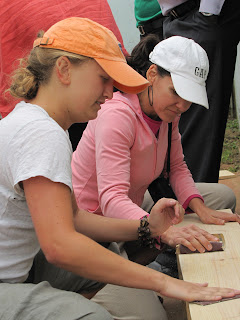Let me tell you a bit about Kibera, the second-largest slum in the world, the largest in Africa. The statistics vary but it seems to be generally agreed that somewhere between two and two-and-one-half million people inhabit 2 square miles. Houses- such as they are- are quite literally on top of one another and from the outside edges of Kibera, where roads can accomodate one car-width, the streets get narrower and narrower, until in the center, streets are barely wide enough to permit two people to pass one another.
With no electricity, the place becomes dark and dangerous when night falls. With no running water, people are forced to carry water from several taps maintained by the government for that purpose. With no sewage system, raw human waste runs in the streets or is placed in bags on the roofs of houses where it is susceptible to both vermin and weather. One of the estimates I have heard is that more than 500,000 children in Kibera do not go to school, which means that this extreme poverty will be perpetuated for yet another generation.
 Stretching as far as the eye can see, these "houses", each composed of one room and sometimes housing as many as 14 or 15 people, are the growing-up place for thousands of children, the dying place of countless more.
Stretching as far as the eye can see, these "houses", each composed of one room and sometimes housing as many as 14 or 15 people, are the growing-up place for thousands of children, the dying place of countless more.
The desire to bring hope and education to children orphaned by AIDS and now being cared for by their grandmothers is what has prompted the Nyanya Project. Having spent time at the Pre-School Center, seeing these children being fed and educated and cared for by loving adults five days a week makes me more determined than ever to have more and more such centers established. With the rental of a larger property (where considerable renovations must take place), a second center will begin- we deeply hope- this fall. Both centers will be housed in the same building, which will have a play yard outdoors, an indoor kitchen, several classrooms, a office, and bathroom facilities. In all, a total of 80 children will be able to attend, with the goal of preparing them for elementary school, as well as teaching them good health skills and providing nourishing food (which might well be the only food they get each day). The grandmothers working at the center mix a "porridge" of several difference grains (very nutrient-filled) which the children drink each day in addition to their lunch. I found the smell less than appetizing, but the children drink it gladly and ask for more. And a considerable number of the children have grown and are thriving where before they were thin and sickly (most especially those who are HIV-positive).
Yesterday, a group of us spent the morning working with a carpenter and his helper to build some benches for the center. Presently, the children sit on the floor, with no surface on which to write. The benches will serve double- duty: a place to sit when they are eating and a "desk" surface on which to write and color. Tomorrow morning, Maddie and I are going back to paint them in bright colors, which will add some extra cheer to the classroom.
If you'd like to learn more about the Nyanya Project and its work, please visit the website and/or the Facebook page. And if you believe in what we're doing, perhaps consider a contribution to enable us to help more of the grandmothers of these children, the poorest of the poor. For it is in these little ones that the hope for the future lies- their grandmothers realize that, which is why their determination is so great, their dedication so unwavering.





No comments:
Post a Comment